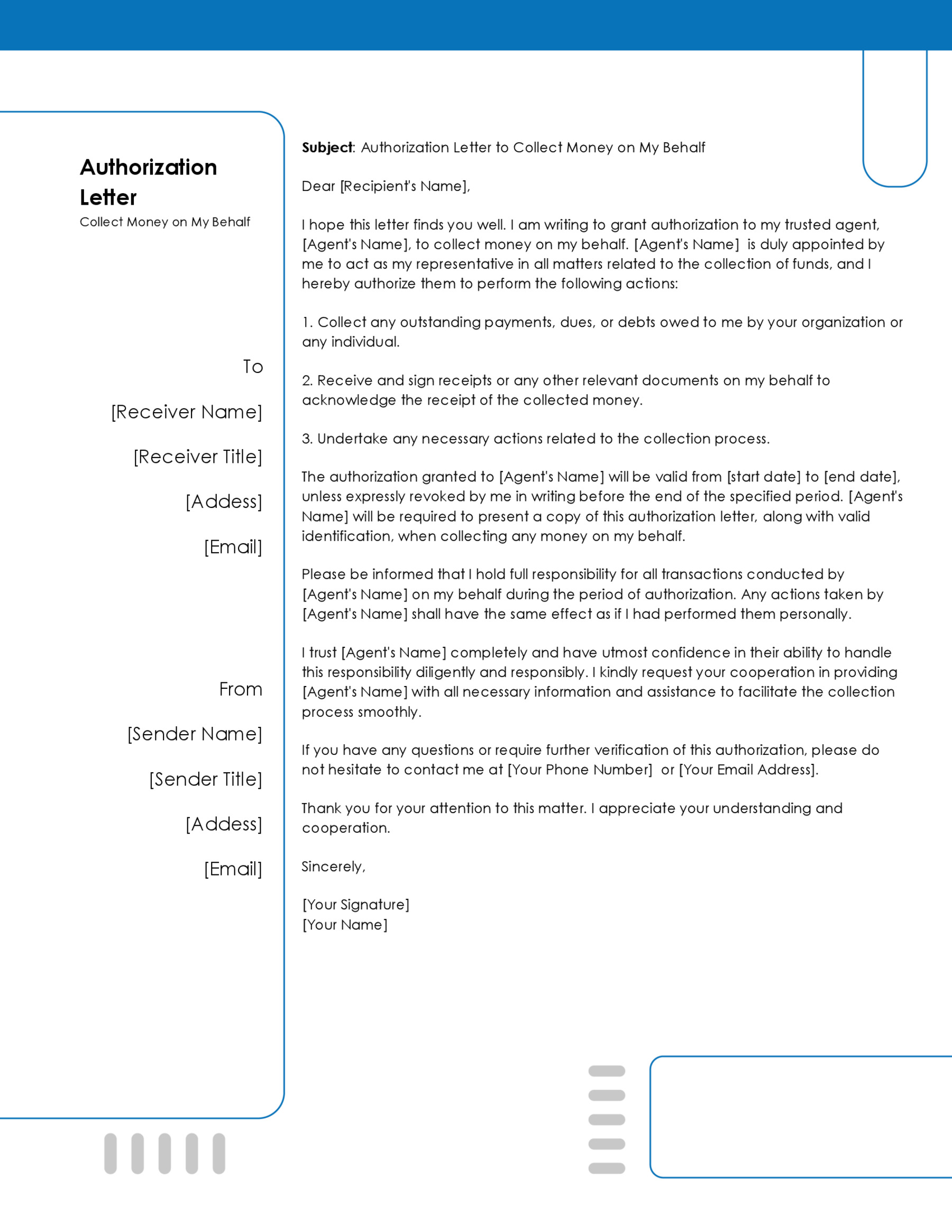An appointment letter is an official letter given to a job candidate after a successful interview informing them that they have been selected or employed for the position.
It is written by the organization (employer) that did the hiring. An appointment represents the official beginning of the employee-employer relationship. Also, it is an indication that the employer is satisfied with the employee’s qualifications and is willing to assimilate them into the organization.
It also presents the employer with an opportunity to express their delight and congratulate the selected candidate. It is advised to start the working relationship on a good note; employers should make sure the employee understands that.
note
An appointment letter is issued soon after the employee-to-be accepts a job offer. It should not be confused with an offer letter, which is written to invite the candidate to join the organization. It is issued after the employee-to-be submits all the required documentation outlined in the offer letter.
Samples and Examples
Below are sample letters that serve as valuable resources for individuals like you who are seeking guidance in creating professional and effective appointment letters. By using these samples, you can benefit from a streamlined process, ensuring clarity, adherence to formalities, and a professional tone, ultimately making a positive impression on the recipients.
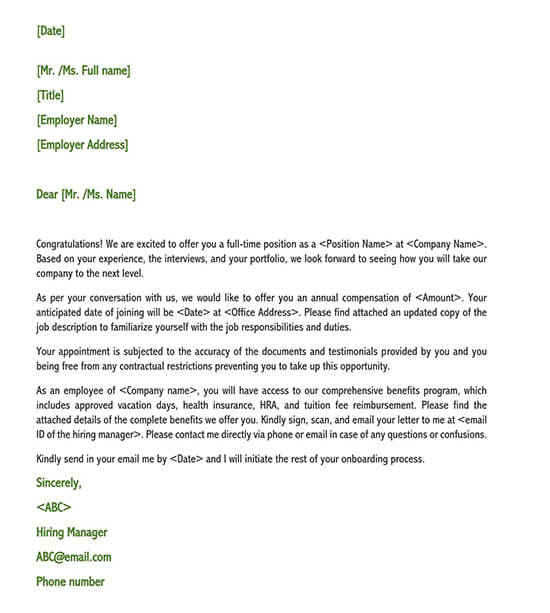
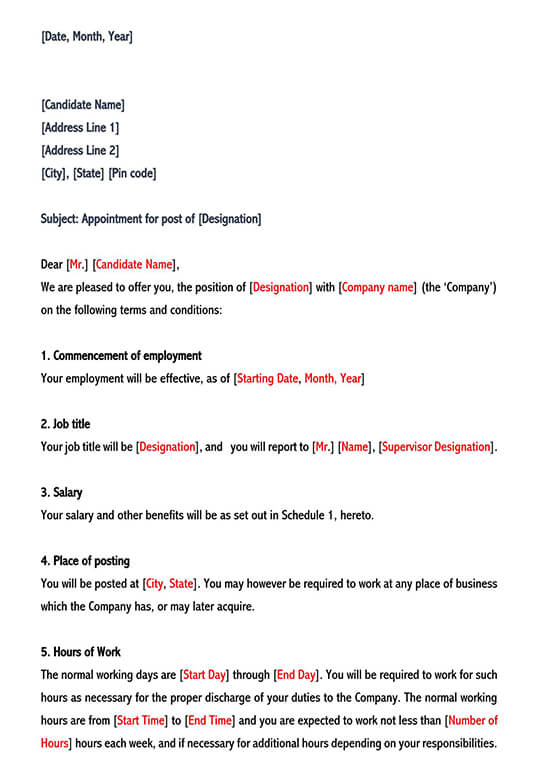
Types of Appointment Letter
Basically, there are three common types of appointment letters namely; Fixed Term, Temporary, and Continuing appointments:
- Fixed Term appointment letters are meant for employees who are hired for a limited period of one year or more. In these letters, the employment may be extended up to two years.
- Temporary appointment letters are formed for employees hired for a short-term period of less than one year. The period after extension should amount to eleven months of service.
- Continuing appointment letters are for employees who work thirty-two hours a week.
Writing an Appointment Letter
As an employer, knowing how to write a standard appointment letter professionally is imperative. The contents of the letter should be structured in a way that effectively communicates its purpose. This article will provide employers with a step-by-step guide on how to write one:
Add a letterhead
The first item that should appear on the appointment letter is the company’s letterhead. A letterhead is a pre-printed heading that is included in organizational documents like letters or memos. It includes the name of the organization, mailing address, contact information, and sometimes the logo or emblem of the company. It is placed in the top center position.
EXAMPLE
FidBit Data and Market Research Company
Address: 36th Marble Ave., Chelsea, NC 1234
Tel: (222) 5638-7367
[Company Email]
tip
For employers who want the letter to look professional and official, including a letterhead is a simple way to achieve this. For example;
Date and employee’s details
After the letterhead, include the date when the letter was written and then the employee-to-be details (recipient). This is inclusive of their name and address. The following item to insert is a salutation.
EXAMPLE
Date: June 5, 20XX,
John Blair,
Address: 2334 Peach Street,
Brighton, NC 3455
Email: example@email.com
Phone number: 3648 (7738)- 647
Dear Mr. Blair,
Inform about appointment
The next step will be to declare the purpose of writing the appointment letter, which is to notify the candidate of their appointment for the position they have applied for.
The following details should appear at this point:
- Welcome the employee. The first paragraph should be written with the purpose of congratulating the employee on securing employment with the organization and welcoming them into the company. This not only confirms employment but also conveys that the company is happy to have employed the individual and is looking forward to their joining the company for immediate deployment.
- Mention the position. It should be made clear which designation the candidate has been offered. The designation should be specific, and vagueness should be avoided. Do not leave it for the employee to conclude for themselves. For example, titles like “Manager” are not enough to specify the position; opt to include more details like “Assistant Administrator of The Head Office, New York.”
- Add the reporting date. Let the employee-to-be know when they are required to start the job. The date should be given in the format of date, month, and year for specificity.
- Terms and conditions. Jobs always come with terms and conditions. It is the duty of the employer and the right of the employee to be informed of applicable terms and conditions before agreeing to accept a job. Remember, terms and conditions are typically mentioned during the recruitment process. Terms and conditions address the following aspects of the employment position.
- Salary – The amount of money the employee-to-be will be compensated for their contribution to the organization should be indicated.
- Working hours – State the number of hours they are required to work in a week. It must also be clear when working hours begin and end.
- Leave policy – Employees are entitled to a number of leaves per year. Where the number varies from one organization to another, an employer should award his or her employees leave for reasons such as maternity leave, vacation, earned leave, etc. the appointment letter should clarify the company’s policy on leaves.
- Notice period – The letter should also state how many days employees have prior to issuing an employment termination notice before leaving the company. Indicate to whom the notice should be addressed.
- Bonus details – Sometimes, employers award bonuses to their employees for exemplary efforts or certain duties/activities. The appointment letter should state if this is the case in the organization. Again, this can be an incentive for them to join the company.
EXAMPLE
It is with great joy that I am informing you of your appointment as the Chief Data Analyst at FidBit Data and Market Research Company. Your official duties will begin as of June 30, 20XX, under the following terms and conditions.
Salary: $20000 per month.
Working hours: The official working hours will be 40 hours per week, or 8 hours a day. You are expected to work from 9:30 a.m. to 5:30 p.m. from Monday to Friday. You shall be entitled to a 30-minute lunch break at your convenience within working hours.
Leave policy: Employees of FidBit are entitled to vacation, maternity leave, holiday leave, and ailment leave as stipulated in the company constitution, Article 34A. Management shall not be liable for any false interpretation or lack thereof of the company’s constitution.
Benefits: As the Chief Data Analyst, you shall be entitled to health benefits, transportation coverage, and a pension as outlined in the company constitution, Article 5.
Probation period: You shall be subjected to 8-week probation starting on June 30, 20XX, and ending on August 8, 20XX.
Include employment “at will”
This statement is included in all appointment letters and the meaning and purpose of employment “at-will” is basically the right of the employer to terminate the employee without having to state or explain the cause of termination of employment. This should be included in the letter.
Mention the trial period (if any)
If the employee-to-be will be subjected to a trial period, also known as probation, it should be stated at this point. Employers use probationary periods to evaluate the employee’s performance and determine if they are indeed a good fit for the job, so it is not a promise of permanent employment.
note
Employers cannot subject employees to a probationary period without informing them of its execution.
Mention applicable taxes and deductions
Inform the employee-to-be of applicable deductions and taxes. This ensures they are aware of the taxes and deductions they will be subjected to, and once they accept the job, they cannot claim to have been misinformed. Providing this information protects the employer from potential lawsuits from employees claiming they are being wrongly deducted and taxed.
tip
Do not assume the employee-to-be is aware of all taxes and deductions that are applicable in the organization. Not including this information in an appointment letter can be termed an intentional omission of pertinent information that is influential on the employee’s decision to accept the position.
Outline the responsibilities
Next, make the duties and responsibilities that come with the job known to the employee-to-be. Be as specific as possible. The last thing employees want is to sign up for a job that is associated with certain responsibilities, only to find out they are being assigned different roles.
EXAMPLE
Below are your responsibilities in the company:
- Collection and interpretation of data on sales numbers, logistics, market research, and other behaviors from our clients.
- Analyzing data.
- Reporting results obtained from analysis and identifying patterns of interconnected data sets.
- Develop ways to optimally utilize data to help our clients.
Add other details
After outlining the employee’s responsibilities, add any miscellaneous information that is important for the employee to be aware of. For example, some of the details that can be included in this section are details about travel and transfers. Since some jobs require movement from one place to another, it is important to inform the employee-to-be so that when making the decision to accept the offer, they are aware of what the employer expects of them.
Signatures
An appointment letter, like all official letters, ought to have a closing. The employer can close the letter by including a congratulatory statement and reassurance of their support for the appointment. Afterward, the employer can sign off the letter with a complimentary close, their name, and signature. Just below the employer’s name, there should be a provision for the employee to sign as an acceptance of the job. The employee is also expected to include the date of signing.
EXAMPLE
Finally, we congratulate you for getting this appointment and look forward to working with you.
Sincerely,
[Employer signature]
Angie Brown
Human Resources
[Employee signature]
[Name of employee]
Here’s a list for your reference:
- Address of the employee
- Salutations
- Congratulations and welcome paragraph
- Essential information
- Signature and date
Free Template for Appointment Letter
[Your Company Name]
[Company Address]
[City, State ZIP Code]
[Date]
[Applicant’s Full Name]
[Applicant’s Address]
[City, State ZIP Code]
Dear [Applicant’s Full Name],
We are pleased to extend an offer of employment for the position of [Position Title] at [Your Company Name]. Your qualifications and experience make you an excellent fit for our team, and we are excited about the prospect of having you on board.
Terms of Employment:
1. Position: [Position Title]
2. Department: [Department Name]
3. Start Date: [Start Date]
4. Salary: [Annual Salary]
5. Work Hours: [Number of Work Hours per Week]
6. Reporting To: [Supervisor/Manager’s Full Name and Position]
Responsibilities:
In this role, you will be responsible for [Brief overview of key responsibilities associated with the position].
Conditions of Employment:
Before your start date, we require [Specify any conditions such as background check, drug test, etc.].
Benefits:
As an employee, you will be entitled to [Specify benefits such as health insurance, retirement plans, etc.].
Probation Period:
There is a probationary period of [Specify duration, if applicable].
Termination Clause:
Employment may be terminated by either party under [Specify conditions for termination].
Confidentiality Agreement:
[If applicable, include any confidentiality agreements or non-disclosure clauses].
Acceptance Deadline:
We kindly request that you confirm your acceptance of this offer by [Acceptance Deadline].
Please review this offer carefully and reach out to [HR Contact Person] at [HR Contact Email] or [HR Contact Phone Number] if you have any questions or require further clarification.
We are excited about the possibility of you joining [Your Company Name]. Congratulations, and we look forward to a successful collaboration.
Sincerely,
[Your Full Name]
[Your Position]
[Your Contact Information]
Sample Job Appointment Letters
Sample 01
Dear Jane McArthur,
I am delighted to extend an offer of employment for the position of Graphic Designer at PixelCraft Studios. Your exceptional talent and passion for design, as demonstrated during the interview process, align seamlessly with our creative vision.
Terms of Employment:
1. Position: Graphic Designer
2. Department: Creative
3. Start Date: March 1, 20XX
4. Salary: $50,000 per annum
5. Work Hours: 40 hours per week
6. Reporting To: Ms. Olivia Artisan, Creative Director
As a Graphic Designer, your key responsibilities will include:
- Crafting visually captivating designs for diverse digital and print materials, ranging from engaging social media graphics to compelling marketing collateral and website elements.
- Collaborating closely with the dynamic marketing team to grasp project requirements and deliver design solutions that resonate with PixelCraft Studios’ brand identity.
- Ensuring the uniformity and high quality of design assets across all communication channels.
- Staying abreast of the latest industry trends and infusing innovative design techniques into your work.
Before your start date, we require the successful completion of a background check and the submission of any necessary documentation.
In addition to your annual salary, you will be entitled to a comprehensive benefits package, including:
- Health insurance coverage, encompassing dental and vision options.
- Opportunities for professional development, with access to workshops and conferences.
- Generous paid time off, including vacation days and company holidays.
There is a three-month probationary period, during which both parties can assess compatibility and performance.
During the probationary period, employment may be terminated by either party with two weeks’ notice or equivalent compensation in lieu of notice.
We kindly request that you confirm your acceptance of this offer by February 15, 20XX.
We are confident that your artistic flair will make a lasting impact at PixelCraft Studios. Should you have any questions, please feel free to contact Ms. Olivia Artisan at olivia.artisan@pixelcraftstudios.com or (555) 123-4567.
We eagerly anticipate the opportunity to work with you and welcome you to our vibrant creative team.
Congratulations, and we look forward to your imaginative contributions.
Sincerely,
Oliver Designer
Creative Manager
PixelCraft Studios
Sample 02
Dear Dr. Leslie Gale,
I am thrilled to extend an offer of employment for the position of Assistant Professor of Botany at Verdant University. Your exceptional research achievements and commitment to advancing botanical knowledge align seamlessly with our academic mission.
Your starting date would be March 1, 20XX against a compensation package of $80,000 per annum. You will also be eligible for a research grant of $15,000 per academic year to facilitate your research and contributions to the field.
In this role, you will be responsible for conducting innovative research in the field of botany, actively contributing to our university’s research agenda. Your teaching load will consist of 20 hours per week, encompassing both lectures and laboratory sessions, providing invaluable mentorship to students in the Department of Biological Sciences. Additionally, your role involves participating in collaborative research projects with fellow faculty members and external partners, fostering a dynamic academic environment.
In addition to your annual salary, you will be entitled to a comprehensive benefits package, including health insurance coverage encompassing medical, dental, and vision options. We also offer retirement plans with employer contributions and professional development opportunities, including conference attendance and additional research grants. Furthermore, after three years of continuous service, you will be eligible for a sabbatical leave to further pursue your research interests or engage in professional development.
Before your start date, we require the successful completion of all necessary onboarding processes, including documentation submission and orientation sessions. The acceptance deadline for this offer is February 15, 20XX.
We are confident that your expertise will significantly contribute to the academic success of Verdant University. Should you have any questions, please feel free to contact Dr. Richard Greenleaf, Head of Department, at richard.greenleaf@verdantuniversity.edu or (555) 123-4567.
We eagerly anticipate the opportunity to welcome you to our esteemed faculty.
Congratulations, and we look forward to your scholarly contributions.
Sincerely,
Professor Olivia Greenwood
Provost
Verdant University
Related Samples, Formats, and Templates
- Job Appointment Letter Samples – Letters to Appoint for a Job
- Temporary Appointment Letter Samples – Letters to assign temporary appointments.
- Employee Appointment Letter Samples – To write appointment letters to employees.
- Trainee Appointment Letter Formats – To appoint a trainee to the department.
- Company Appointment Letter Templates – Writing appointment letters for a Company.
- Internship Appointment Letter Formats – Free formats for internship appointment letters.
- Agent Appointment Letter Examples – To request an appointment with an agent of an agency.
Professional Tips for Writing
As an employer, there are certain things one can take into consideration or adopt when writing an appointment letter to improve its quality. They include:
- Choose the right font style and size: Considering that it is a formal letter, it has to be legible and neatly presented. The way to achieve this is by selecting an appropriate font such as Cambria, Times New Roman, or Calibri and using a font size of between 10 and 12 (12 being the most preferred).
- Present necessary details: It should present all the pertinent information pertaining to the appointment. The information given in the letter should be enough to assist the employee-to-be in making a decision. Do not force the candidate to have to call to get important details, such as salary. However, even if one feels like they have given all the necessary information, they should always include contact details that the employee-to-be can use in case they have any queries.
- Keep it clear and brief: The letter should be kept short and to the point. Avoid including unnecessary information that does not add value to the letter. Lengthy appointment letters tend to be monotonous and full of repetition, two undesirable qualities of formal documents. Brief letters also help the employer avoid contradictory statements that can be misinterpreted.
- Avoid sarcasm or informal phrases: Slang should be avoided throughout the letter. Keep in mind that it is an official document. Therefore, statements should be written so that they mean exactly how they can be interpreted. Rhetoric and sarcastic statements must be avoided. Also, avoid writing words in all capitals, for it is seen as a command and is impolite.
- Check grammatical errors: The letter should be error-free, that is, with no grammatical or typographical errors. These can be avoided by proofreading the letter once one finishes writing. Such errors are seen as a lack of keenness and are a sign of low levels of professionalism.
Free Downloads
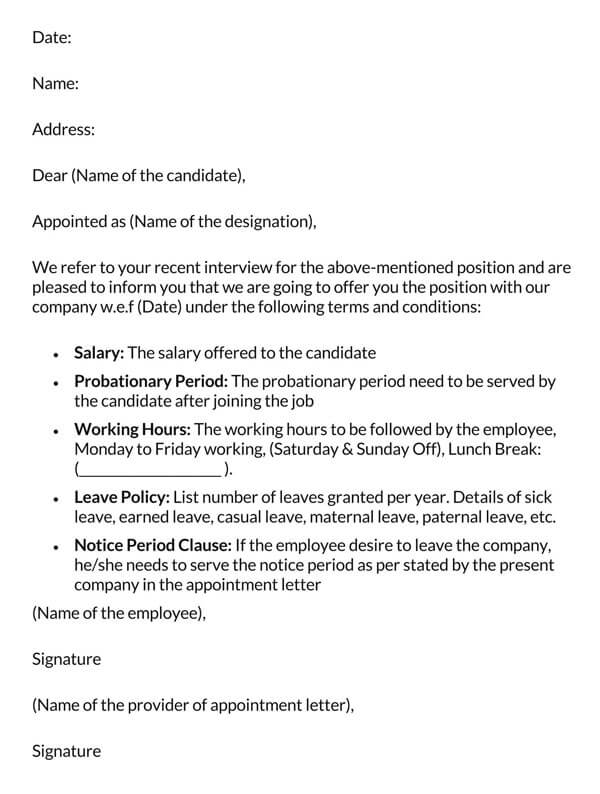
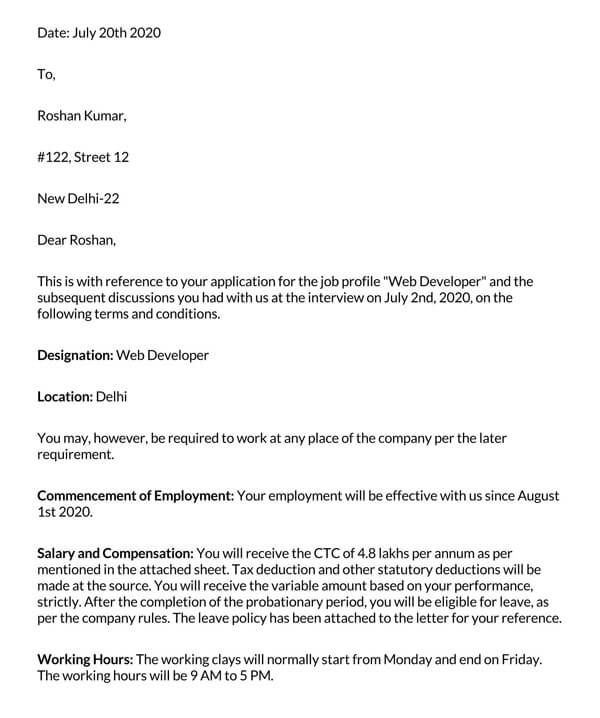
Conclusion
An appointment letter is written by an employer to the selected candidate after the interview process. Employers can write it from scratch or use a template. The fundamental elements of this letter include company letterhead, employee information, salutation, designation, date of joining, terms and conditions of employment, congratulatory statement, and letter closing. Appointment letters should maintain a positive tone all through. Vague statements and phrases should be avoided, for once the employee-to-be signs it, they are entitled to what was communicated in the letter, and if there is room for misinterpretation, it might be costly to the employer.










